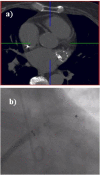Percutaneous Left Atrial Appendage Exclusion Therapy: Who, Why and How?
- PMID: 28496638
- PMCID: PMC5398826
- DOI: 10.4022/jafib.178
Percutaneous Left Atrial Appendage Exclusion Therapy: Who, Why and How?
Abstract
Purpose: Patients with atrial fibrillation are at an increased risk of having a cardio embolic stroke. Stroke is a leading cause of death and disability worldwide. Current guidelines recommend an antithrombotic regimen to prevent thromboembolism in medium and high risk patients with AF. However, a substantial number of patients are not eligible for this therapy. The exclusion of the left atrial appendage (LAA) from circulation seems to be an alternative strategy for stroke prevention in AF. This review focuses on the different strategies for LAA exclusion with special focus on the WATCHMAN Device. Two devices are currently in use for percutaneous transcatheter occlusion of the LAA: the WATCHMAN® - device and the AMPLATZER® -septal occluder. For both devices safety and feasibility data are available. Additionally about 200 patients received a PLAATO® -device- which is currently no more available due to economic reasons. Patients treated with the PLAATO device were at high risk for thromboembolic stroke and had contraindications for oral anticoagulation therapy. The Watchman® -device was implanted in 800 patients that were eligible for long-term anticoagulation therapy with a moderate risk for thromboembolic stroke due to non-valvular AF. Summary: For both devices, a reduction in the risk of stroke was documented and device implantation was shown to be safe and feasible. Provided the ongoing trials show noninferiority to oral anticoagulation, another therapeutic option will become available to prevent ischemic strokes.
Figures



Similar articles
-
Interventional treatments for stroke prevention in atrial fibrillation with emphasis upon the WATCHMAN device.Curr Opin Neurol. 2008 Feb;21(1):64-9. doi: 10.1097/WCO.0b013e3282f419b6. Curr Opin Neurol. 2008. PMID: 18180653 Review.
-
Left atrial appendage exclusion for stroke prevention in patients with nonrheumatic atrial fibrillation.Stroke. 2007 Feb;38(2 Suppl):624-30. doi: 10.1161/01.STR.0000250166.06949.95. Stroke. 2007. PMID: 17261703 Review.
-
Left atrial appendage exclusion-Where do we stand?J Thorac Dis. 2014 Mar;6 Suppl 1(Suppl 1):S70-7. doi: 10.3978/j.issn.2072-1439.2013.10.24. J Thorac Dis. 2014. PMID: 24672702 Free PMC article. Review.
-
Percutaneous transcatheter left atrial appendage exclusion in atrial fibrillation.J Invasive Cardiol. 2008 Apr;20(4):E109-13. J Invasive Cardiol. 2008. PMID: 18398240 Review.
-
Left atrial appendage exclusion using an Amplatzer device.Int J Cardiol. 2009 May 1;134(1):e1-3. doi: 10.1016/j.ijcard.2007.12.028. Epub 2008 Feb 13. Int J Cardiol. 2009. PMID: 18272242
References
-
- Go A S, Hylek E M, Phillips K A, Chang Y, Henault L E, Selby J V, Singer D E. Prevalence of diagnosed atrial fibrillation in adults: national implications for rhythm management and stroke prevention: the AnTicoagulation and Risk Factors in Atrial Fibrillation (ATRIA) Study. JAMA. 2001 May 09;285 (18):2370–5. - PubMed
-
- Furberg C D, Psaty B M, Manolio T A, Gardin J M, Smith V E, Rautaharju P M. Prevalence of atrial fibrillation in elderly subjects (the Cardiovascular Health Study). Am. J. Cardiol. 1994 Aug 01;74 (3):236–41. - PubMed
-
- Gage B F, Waterman A D, Shannon W, Boechler M, Rich M W, Radford M J. Validation of clinical classification schemes for predicting stroke: results from the National Registry of Atrial Fibrillation. JAMA. 2001 Jun 13;285 (22):2864–70. - PubMed
-
- Fuster Valentin, Rydén Lars E, Cannom David S, Crijns Harry J, Curtis Anne B, Ellenbogen Kenneth A, Halperin Jonathan L, Le Heuzey Jean-Yves, Kay G Neal, Lowe James E, Olsson S Bertil, Prystowsky Eric N, Tamargo Juan Luis, Wann Samuel, Smith Sidney C, Jacobs Alice K, Adams Cynthia D, Anderson Jeffery L, Antman Elliott M, Halperin Jonathan L, Hunt Sharon Ann, Nishimura Rick, Ornato Joseph P, Page Richard L, Riegel Barbara, Priori Silvia G, Blanc Jean-Jacques, Budaj Andrzej, Camm A John, Dean Veronica, Deckers Jaap W, Despres Catherine, Dickstein Kenneth, Lekakis John, McGregor Keith, Metra Marco, Morais Joao, Osterspey Ady, Tamargo Juan Luis, Zamorano José Luis. ACC/AHA/ESC 2006 Guidelines for the Management of Patients with Atrial Fibrillation: a report of the American College of Cardiology/American Heart Association Task Force on Practice Guidelines and the European Society of Cardiology Committee for Practice Guidelines (Writing Committee to Revise the 2001 Guidelines for the Management of Patients With Atrial Fibrillation): developed in collaboration with the European Heart Rhythm Association and the Heart Rhythm Society. Circulation. 2006 Aug 15;114 (7):e257–354. - PubMed
-
- Risk factors for stroke and efficacy of antithrombotic therapy in atrial fibrillation. Analysis of pooled data from five randomized controlled trials. Arch. Intern. Med. 1994 Jul 11;154 (13):1449–57. - PubMed
Publication types
LinkOut - more resources
Full Text Sources
